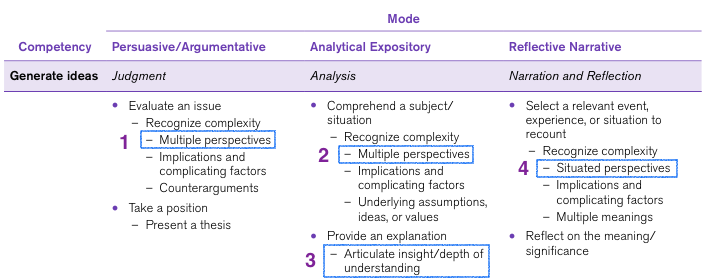
Did you know that the ACT Writing Test changed dramatically in Fall 2015? You might not, because people haven't talked about it much, but it changed the ACT and possibly standardized testing in general. It's scored based on all of the old ACT's criteria, but also on a number of new concepts.
We've written the most comprehensive guide available on the new ACT Writing section. Keep reading to find out how you can prepare for and ace this new test.
Because there's a lot to cover, we've divided this article into 3 sections, each exploring a major change in the new ACT Writing assignment:
Part 1: Expanded Prompts
Part 2: More Open-Ended Assignment
Part 3: Redesigned Scoring Criteria
Before we dive into this, it's useful to understand why they're changing the ACT Essay section, because this will help you write a better essay.
Why Is the Writing Section Changing?
One of colleges' biggest complaints about high school graduates is that their writing isn't academic or complex enough. Because the ACT is trying to position itself not only as a college entrance exam but also as a state-mandated graduation benchmark, it's always trying to stay relevant to the modern education system, and the Enhanced ACT Writing Test is a big part of that.
ACT, Inc. gives a number of reasons for the changes to the essay assignment.
The simplest explanation they give is that it "will allow students to more fully demonstrate their analytical writing ability." Edward R. Colby, a spokesman for ACT, has also commented on the increased complexity of the Enhanced ACT Writing assignment: “It won’t be ‘this side or that side,’” Mr. Colby said. “The question will ask students for multiple perspectives and support. It will be a more-complex prompt than what we’re delivering now.”
But the real motivations behind the redesigned ACT Writing test are related to broader changes in education. Until recently, each state decided what to teach its students, and many students were graduating from high school totally unprepared for college.
So in 2010, the National Governors Association released the Common Core standards in English and math. Forty-four of the fifty U.S. states and the District of Columbia have adopted the Common Core State Standards Initiative. The Grades 11-12 Common Core Writing Standards include references to three very specific types of writing:
- "Write arguments to support claims in an analysis of substantive topics or texts, using valid reasoning and relevant and sufficient evidence."
- "Write informative/explanatory texts to examine and convey complex ideas, concepts, and information clearly and accurately through the effective selection, organization, and analysis of content."
- "Write narratives to develop real or imagined experiences or events using effective technique, well-chosen details, and well-structured event sequences."
As you'll be able to see in the scoring criteria later in the article, these three modes of writing correlate directly to the newly-added columns of writing modes in the ACT's new Writing Competencies Model.
Will the Enhanced ACT Writing Test Matter More to Colleges?
We don't yet know whether these changes will make the writing test more relevant to colleges, most of which don't require applicants to submit writing scores. But some of those colleges are big, and over 50 percent of high-school seniors are still writing essays when they take the ACT.
Ultimately, colleges won't change their policies until the 2015 new ACT Writing test has been administered a few times, to see what the scores end up reflecting. For example, the old ACT essay is generally considered to be a somewhat skewed measure of students' writing ability. It can't test, as the Enhanced ACT Essay claims to, "insight/deeper understanding through thoughtful consideration." The closest it comes to testing "insight" is whether the examples logically support the point being made. It appears, though, that the new version is trying to capture more of the depth and meaning of an essay than has been attempted by standardized tests so far.
PART I: Expanded Prompts
While ACT, Inc. has only released a few sample prompts for the Enhanced ACT Writing section, we can learn a lot from them. The prompts are longer, more complicated, and cover a broader range of topics than the old prompts did.
The topic of the old prompts mostly covered high school and education. They gave a paragraph on the topic and asked only that you "take a position" and support it.
Old Prompt Style and Topic
Here's the old style of prompt (this is all of it):
Rather than concentrating on doing one thing at a time, high school students often divide their attention among several activities, such as watching television and using the computer while doing homework. Some educators believe multitasking is a bad practice when doing homework because they think dividing attention between multiple tasks negatively affects the quality of students' work. Other educators do not believe multitasking is a bad practice when doing homework because they think students accomplish more during their limited free time as a result of multitasking. In your opinion, is it too distracting for high school students to divide their attention among several activities when they are doing homework?
In your essay, take a position on this question. You may write about either one of the two points of view given, or you may present a different point of view on this question. Use specific reasons and examples to support your position.

The old ACT prompts were all about topics related to high schoolers and high school education. And as you'll read next, that is no longer true with the introduction of the Enhanced ACT Writing Test.
New Prompt Style and Topics
The redesigned ACT Writing prompts are much more complex. They start with a passage about the same length as the old one, shown below. Notice that the prompt does not ask a specific question about the information.
The prompt topic below, about the mechanization of the workforce, is a broad and often controversial issue in modern society. As you can see, it has nothing to do with high school or education.
Note: in the prompt below, released by the ACT, the emphasis (in italics) of certain key phrases has been added by the editor.
Intelligent Machines
Many of the goods and services we depend on daily are now supplied by intelligent, automated machines rather than human beings. Robots build cars and other goods on assembly lines, where once there were human workers. Many of our phone conversations are now conducted not with people but with sophisticated technologies. We can now buy goods at a variety of stores without the help of a human cashier. Automation is generally seen as a sign of progress, but what is lost when we replace humans with machines? Given the accelerating variety and prevalence of intelligent machines, it is worth examining the implications and meaning of their presence in our lives.

Since this is one of five prompts the ACT has released, we don't know anything about the range of topics they'll be covering. But we can draw some basic conclusions about their scope and structure.
The Anatomy of the New ACT Writing Prompt
Let's break down the new prompt, sentence by sentence.
Sentence 1: General statement about "intelligent, automated machines" providing "goods and services"
Sentences 2-4: Three specific examples of robots replacing human workers
Sentence 5: Core question, "what is lost when we replace humans with machines?"
Sentence 6: Instruction, "[Examine] the implications and meaning of [intelligent machines'] presence in our lives."
As you can see, the instruction in Sentence 6 is phrased somewhat abstractly—it just says the topic is "worth examining." But since this is an essay prompt, we know that that sentence is actually telling us what it wants us to do. But that's not all!
Added Perspectives, a.k.a. Points of View
In addition to the large text prompt above, the Enhanced ACT Writing test gives you three different perspectives on the issue in the passage:
| Perspective One What we lose with the replacement of people by machines is some part of our own humanity. Even our mundane daily encounters no longer require from us basic courtesy, respect, and tolerance for other people. | Perspective Two Machines are good at low-skill, repetitive jobs, and at high-speed, extremely precise jobs. In both cases they work better than humans. This efficiency leads to a more prosperous and progressive world for everyone. | Perspective Three Intelligent machines challenge our long-standing ideas about what humans are or can be. This is good because it pushes both humans and machines toward new, unimagined possibilities. |
Let's simplify the three perspectives:
1) Mechanization is related to and a symbol of perceived modern cultural disintegration (It's bad).
2) The efficiency of mechanization can only benefit humanity (It's good because it's efficient).
3) Mechanization is good because it tests our ideas about humanity (It's good because it challenges us).
There's no way to know what the perspectives will be on future redesigned ACT Writing prompts, but it's safe to say that at least one will be positive and at least one will be negative. We'll explain what you're supposed to do with these perspectives below.
PART II: More Open-Ended Assignment
After the ACT presents you with this heap of information, it finally gives some specific instructions on what it wants you to do.
Revised & Expanded Instructions and Hints
Here's the new 2015 ACT Writing Essay Task. It's safe to assume that this will be the same in every subsequent ACT Writing test.
Essay Task
Write a unified, coherent essay about the increasing presence of intelligent machines. In your essay, be sure to:
- clearly state your own perspective on the issue and analyze the relationship between your perspective and at least one other perspective
- develop and support your ideas with reasoning and examples
- organize your ideas clearly and logically
- communicate your ideas effectively in standard written English
Your perspective may be in full agreement with any of the others, in partial agreement, or wholly different.
There are a few new important things to note here: you now must not only choose a perspective on the issue (which, to make your life easier, should be one of those given), but also must discuss the relationship between the perspective you choose and at least one of the others. This is significantly more challenging than the amount of analysis you were expected to do in the old ACT Writing test. We'll get more deeply into this in a moment.
New: Focus on Planning
But wait! There's more! On a second page, the Enhanced ACT Writing Test gives space for planning your essay, and reminders of some things to consider including:
Planning Your Essay
Your work on these prewriting pages will not be scored.
Use the space below and on the back cover to generate ideas and plan your essay. You may wish to consider the following as you think critically about the task:
Strengths and weaknesses of the three given perspectives
- What insights do they offer, and what do they fail to consider?
- Why might they be persuasive to others, or why might they fail to persuade?
Your own knowledge experience and values
- What is your perspective on this issue, and what are its strengths and weaknesses?
- How will you support your perspective in your essay?
You can see, given the instructions, that there are a lot of elements to consider. It's a lot more open-ended than the old ACT essay.
How Has the Assignment Changed?
In the old ACT essay, you had 2 jobs: take a position on the topic (and defend it), and address (and disqualify) the opposing perspective to your own.
In the Enhanced ACT Writing, you have still have 2 analytical jobs, but the specifics of the jobs have changed. You still have to take a position on the topic (and defend it), but, and this is the most novel part, you also have to discuss the relationship between the perspectives.
The ACT gives you space in the essay booklet that's specifically for planning (to emphasize that planning is CRUCIAL to the assignment) and contains ideas for brainstorming support. Unfortunately, the ideas they give are a bit obtuse. Let's translate them into simpler wording:
- "What insights do they offer, and what do they fail to consider?"
- = how is each perspective right and wrong?
- "Why might they be persuasive to others, and how might they fail to persuade?"
- = why would people agree or disagree with each perspective?
- "What is your perspective on the issue, and what are its strengths and weaknesses?"
- = think about the perspective you choose and make sure it's easy to support (which, hopefully, you'd do automatically)
- "How will you support your perspective?"
- = the same thing you had to do on the old ACT essay: think of reasons and examples that show the validity of your argument
PART III: Redesigned Scoring Criteria
The old ACT Writing score criteria were in paragraph form, by score, and not broken down into categories.
Let's take a look.
The Old ACT Essay Scoring Criteria
Score = 6
Essays within this score range demonstrate effective skill in responding to the task.
The essay shows a clear understanding of the task. The essay takes a position on the issue and may offer a critical context for discussion. The essay addresses complexity by examining different perspectives on the issue, or by evaluating the implications and/or complications of the issue, or by fully responding to counterarguments to the writer's position. Development of ideas is ample, specific, and logical. Most ideas are fully elaborated. A clear focus on the specific issue in the prompt is maintained. The organization of the essay is clear: the organization may be somewhat predictable or it may grow from the writer's purpose. Ideas are logically sequenced. Most transitions reflect the writer's logic and are usually integrated into the essay. The introduction and conclusion are effective, clear, and well developed. The essay shows a good command of language. Sentences are varied and word choice is varied and precise. There are few, if any, errors to distract the reader.
By contrast, the ACT's new "writing competencies model" looks really complicated, but much of it is the same as the old ACT essay requirements. The major categories are still the same—"generate ideas" is the same as "takes a position and supports it" and so on.
Let's look at each section; the items in blue boxes are the newly-introduced elements. However, it's not 100% accurate to say that all of these are newly introduced. After the new criteria, we break down what's actually new and how it fits into the simpler, older scoring model.
The Redesigned 2015 ACT Essay Scoring Criteria
Generate Ideas

Develop Ideas

Sustain Ideas

Organize Ideas

Communicate Ideas

There's a lot to digest here, so we've created a condensed version of the old ACT scoring criteria on the left and the new additions from the blue boxes above on the right.
| Old ACT Writing, Score of 6 | New ACT Skill Name | Enhanced ACT Writing adds... |
| The essay takes a position on the issue and may offer a critical context for discussion. The essay addresses complexity by examining different perspectives on the issue, or by evaluating the implications and/or complications of the issue, or by fully responding to counterarguments to the writer's position. | Generate ideas (Judgment, Analysis, Narration and Reflection) |
> multiple perspectives > articulate insight/depth of understanding > situated perspectives (context) |
| Development of ideas is ample, specific, and logical. Most ideas are fully elaborated. | Develop Ideas (Develop a Position, Support an Explanation, Give an Account) |
> appeals to emotion/feeling > identify and explore relevant underlying assumptions, ideas, or values > arrive at insight/deeper understanding through thoughtful consideration |
| A clear focus on the specific issue in the prompt is maintained. | Sustain ideas (Focus) | > Nothing New |
| The organization of the essay is clear: the organization may be somewhat predictable or it may grow from the writer's purpose. Ideas are logically sequenced. Most transitions reflect the writer's logic and are usually integrated into the essay. The introduction and conclusion are effective, clear, and well developed. | Organize ideas (Organization) | > Sequence narrative elements effectively |
| The essay shows a good command of language. Sentences are varied and word choice is varied and precise. There are few, if any, errors to distract the reader. | Communicate Ideas (Language Use) |
> Use appropriate voice and tone > Use narrative techniques > Use descriptive vocabulary |
Why Are There 3 Columns of Criteria?
The old ACT was entirely focused, in its instructions and scoring, on the Persuasive/Argumentative mode of writing. You were supposed to analyze the topic thoughtfully, which is part of the Analytical Expository mode, and you were encouraged to use examples, which requires the Reflective Narrative mode. But only the goals of the Persuasive/Argumentative mode were meant to count toward your score.
Like many recent education changes, redesigned ACT Writing scoring is purposely in line with the Common Core state standards, which are meant to improve the U.S.'s competency in relation to the education systems of other countries, and to make sure all students graduate college-ready.
These standards are considered more difficult than previous public school standards, and the changes are somewhat controversial in some circles. In any case, the ACT is now including this more complex (and accurate) view of writing competency in their new essay format.
Let's get more in depth with these two new modes of writing.
Analytical Expository Mode
You've probably written plenty of expository papers for high school, but the redesigned ACT Writing is focusing more on the Analytical part of the description. While the old ACT essay (and the SAT essay) scored only the persuasive elements of the essay—whether your arguments logically supported your point—the new scoring system is meant to reward INSIGHT. This is actually a huge revelation for standardized testing, and is not something that can be scored by a computer.
Reflective Narrative Mode
Really, this could just be called Storytelling. It's supposed to cover any specific examples or personal stories you choose to use to support your thesis. It's the least important of the three modes, both in the ACT essay and in academic writing. We don't need to worry much about these criteria—just give your examples clearly, and try to include all the relevant details. In scoring essays at PrepScholar, we don't find that this is a common problem for students.
Which ACT Writing Test Should I Take?
Most people will probably tell you that the old ACT Writing test was easier than the Enhanced ACT Writing test, and that you should definitely choose it over the new test if you have a choice. But it's a bit more complicated than that: it may be more accurate to say that the old test is more formulaic, scoring only for logical structure rather than actual insight or ability to analyze multiple viewpoints.
If you're the kind of student who writes great essays for English class, or who loves writing well, the redesigned ACT Writing test may be for you. It will take into account analytical skills that aren't part of the old essay, so if you write a really insightful essay for the old test, you won't be rewarded for it. On the redesigned ACT Writing test, you will.
Personally, I've always been the kind of person who hates writing to a formula and who wants all my writing to be interesting and insightful. For that reason, I'd choose the new test.
How Can I Study for the New ACT Writing Test?
Well, since we only have a few prompts, we don't know yet what specific topics you should read up on. But we do know you'll be asked to write about multiple perspectives on common cultural debates, such as nuclear power or government-subsidized health insurance.
So you can google "debate topics," choose a few that are appropriate for high schoolers, and prepare your own prompts: just find three different perspectives on the issue, and then use them to perform the Essay Task above. The ACT may be releasing more information before the redesigned Writing test is administered, so stay tuned to the PrepScholar blog to keep yourself in the know!
What's Next?
If you're researching this topic, you're probably looking to score a pretty high score. Read our guide to how to get a perfect ACT score, written by our 36 ACT scorer.
Also, read our guide on how to get a perfect 12 on the ACT Writing section.
What's a good ACT score for you? Find out how to get your ACT target score, step by step.











